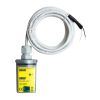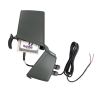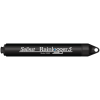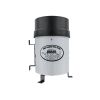RainWise RainLog 2.0 Rainfall Data Loggers
Features
- Utilizes free RL-Loader 2 Software for configuration and data offload
- Powered by two user-replaceable AAA batteries
- Battery monitor LED changes from green to red when battery voltage gets low
- Expedited repair and warranty service
- Lifetime technical support
- More
Overview
The RainWise RainLog 2.0 data logger is RainWise's next-generation Rainfall logger and features numerous improvements in memory capacity, process speed, battery replacement, improved protection and USB Connectivity. This battery-operated logger fits inside most tipping bucket rain gauges. Rainfall is logged at a one-minute resolution and has the capacity for several years of data.
Benefits
- Increased capacity: Flash memory has been increased to 2 MB from 256K
- AAA Batteries: The difficult-to-source lithium CR2477N battery has been replaced with two AAA battery compartments, allowing for easy, un-interrupted replacement in the field
- Battery monitor: The RainLog 2.0 includes a battery monitor LED that changes from green to red when the battery voltage is getting low. The actual battery voltage is also reported in the RL-Loader software
- Rugged Case: Durable case with battery compartment provides better protection
- Improved Protection: Conformal coating to provide better moisture protection
- Processor: Allows for 120% faster downloads
- USB connectivity: A USB mini connector eliminates the need for separate USB converters
In The News
RainWise Weather Stations, Telemetry And Accessories
RainWise is one of the oldest players in the weather monitoring market, having been around since 1974. For reference, that’s only 4 years younger than the U.S. Environmental Protection Agency. Through the years this Maine-based company has logged several advancements in the field starting with RainWise’s very first product, the tipping bucket rain gauge, which is now an industry standard. Since then they have introduced the first consumer digital weather station and the first wireless consumer weather station among other pioneering innovations. With more than 40 years of experience, the products that RainWise produces today are just as inspired.
Read MoreFrom Paddles to Phytoplankton: Studying Vermont’s Wildest Lakes
For six months of the year, Rachel Cray, a third-year PhD student at the Vermont Limnology Laboratory at the University of Vermont, lives between a microscope and her laptop, running data. For the other six months, she is hiking and canoeing four of Vermont’s lakes, collecting bi-weekly water samples. Cray studies algal phenology across four lakes in Vermont, US, that have low anthropogenic stress—or in other words, are very remote. Funded by the National Science Foundation Career Award to Dr. Mindy Morales, the lakes Cray researches part of the Vermont Sentinel Lakes Program, which studies 13 lakes in the area and, in turn, feeds into the Regional Monitoring Network, which operates in the Northeast and Midwest US.
Read MoreReimagining Water Filtration: How Monitoring and Science Enhance FloWater Filtration Systems
Over 50% of Americans think their tap water is unsafe , according to the Environmental Working Group (EWG). Other recent surveys have found that number to be as high as 70% of persons surveyed. Whether due to increased public awareness of water quality issues or confusion about how municipal water sources are regulated, there is a clear distrust of tap water in the United States. According to industry expert Rich Razgaitis, CEO and co-founder of the water purification company FloWater, this issue creates a damaging cycle. Razgaitis explained that the health and environmental problems associated with contaminated water aren’t the only issues. As people become increasingly aware that some tap water is unsafe, they resort to bottled water.
Read More












